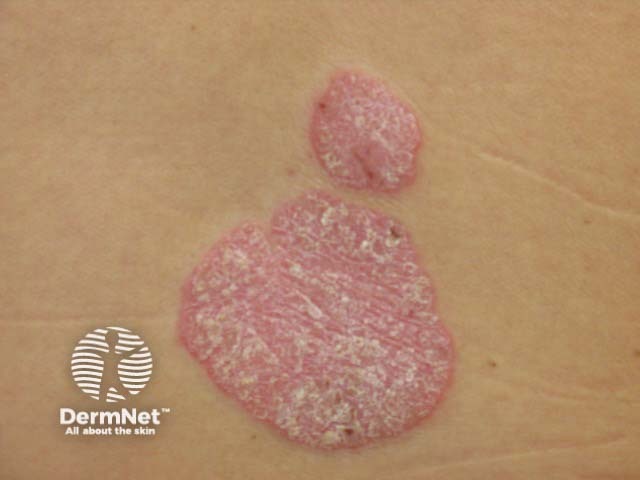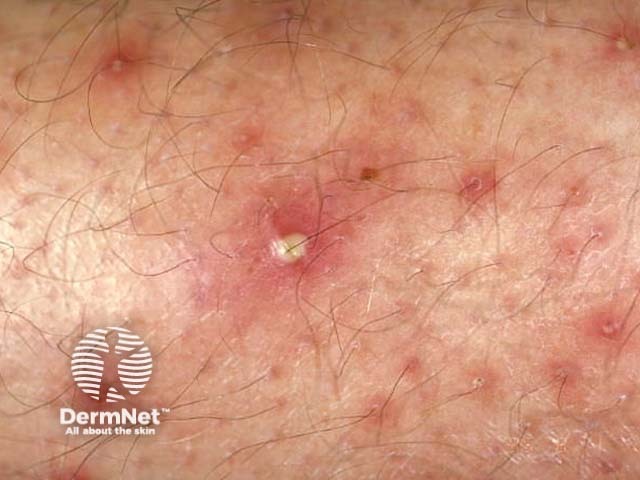Main menu
Common skin conditions

NEWS
Join DermNet PRO
Read more
Quick links
Author: Stewart Shiu, Fifth Year Medical Student, University of Auckland, New Zealand, May 2016.
Introduction Indications Onset of effects Adverse effects Monitoring Cutaneous adverse effects management Drug interactions Topical lithium
Lithium is a chemical element and the lightest of the alkali metals. As it is highly reactive and flammable, it exists in nature in compounds. Lithium salts are used therapeutically in the treatment of mood disorders such as bipolar disorder and depression.
In New Zealand, lithium carbonate (a lithium salt) is fully subsidised and can be prescribed as 250 mg capsules, 250 mg or 400 mg tablets or 400 mg modified release tablets. Trade names include Lithicarb FC and Priadel. It is best taken with food to prevent nausea.
Lithium is indicated for:
Lithium has been used for over 60 years and is a mainstay in both prevention and acute treatment of bipolar disorder. Many placebo-controlled trials have shown its efficacy in reducing the frequency and severity of both the manic and depressive phases of bipolar disorder. It has also been shown to reduce the risk of suicide and death compared to placebo.
If used for acute mania and hypomania, patients will experience a therapeutic effect within 6–10 days. When used for depression, there is a 6–8-week delay in its effect. Used for prevention, it can take 6–12 months before the full therapeutic effect is achieved.
Lithium has a narrow therapeutic index, which means there is a small difference between doses that are effective for treatment and toxic doses. Because of this, regular blood tests are needed to check serum lithium levels. As lithium is excreted from the body through the kidneys, caution is required in patients with renal failure, as they are more likely to suffer from lithium accumulation and toxicity.
The adverse effects of lithium are usually dose-dependent and occur when serum lithium levels are above therapeutic levels.
Nausea, vomiting, anorexia and diarrhoea are more common in the initial stages of lithium therapy when serum lithium levels are not yet stable.
At therapeutic levels, lithium can cause a persistent fine hand tremor, muscle weakness and rarely, extrapyramidal features. Tremors may be treated with a beta-blocker. Patients with lithium toxicity may have impaired consciousness, apathy, hyperreflexia, hypertonia, seizures and rarely, death. Prolonged toxic exposure can lead to brain damage.
Long-term lithium treatment, especially in middle-aged or older women, can result in hypothyroidism and euthyroid goitre, which responds well to treatment with supplementary thyroxine. Hypercalcaemia is reported in 10% of patients. Hypermagnesaemia and hyperparathyroidism have also been noted.
Up to one-third of patients can develop nephrogenic diabetes insipidus, which presents as polyuria and polydipsia and is reversible on discontinuation of lithium. Long-term treatment on lithium can cause irreversible impairment of renal function.
Lithium can cause ECG changes and arrhythmias due to QT prolongation. A recent myocardial infarction is a contraindication to lithium use.
The skin is the organ most commonly adversely affected by lithium.
It can cause the first presentation of a skin disease or can exacerbate an existing disease, such as psoriasis or acne.

Acne

Psoriasis

Folliculitis
Psoriasis is a chronic inflammatory skin disease characterised by well-defined red and scaly plaques.
Acne is a common inflammatory skin disease characterised by comedones (blocked hair follicles).
Tender red pustules characterise folliculitis due to inflammation of hair follicles.
Hair loss affects 12–19% of patients on long-term lithium therapy.
Other skin diseases that have been reported in association with lithium include:
Patients on lithium should undergo regular tests of:
Additional tests may be required, depending on the adverse effect observed, for example, skin biopsy or skin scrapings for mycology.
For many patients, mood disorder may be more disabling than the skin condition, and lithium’s benefits may outweigh its side effects.
Numerous medications have been shown to interact with lithium and either increase or decrease the concentration of lithium in the body.
Examples include:
Topical lithium salts are useful in the treatment of seborrhoeic dermatitis. It is believed to work by reducing the release of fatty acids in the skin. As fatty acids are important for growth in fungi, this reduces the number of fungi on the skin surface.
High local concentration of topical lithium also produces an anti-inflammatory effect, by reducing the production of prostaglandins and other eicosanoids. This allows it to be used to treat other inflammatory skin diseases.
Topical lithium is generally well tolerated and does not raise serum lithium levels significantly. It can cause transient mild skin irritation.